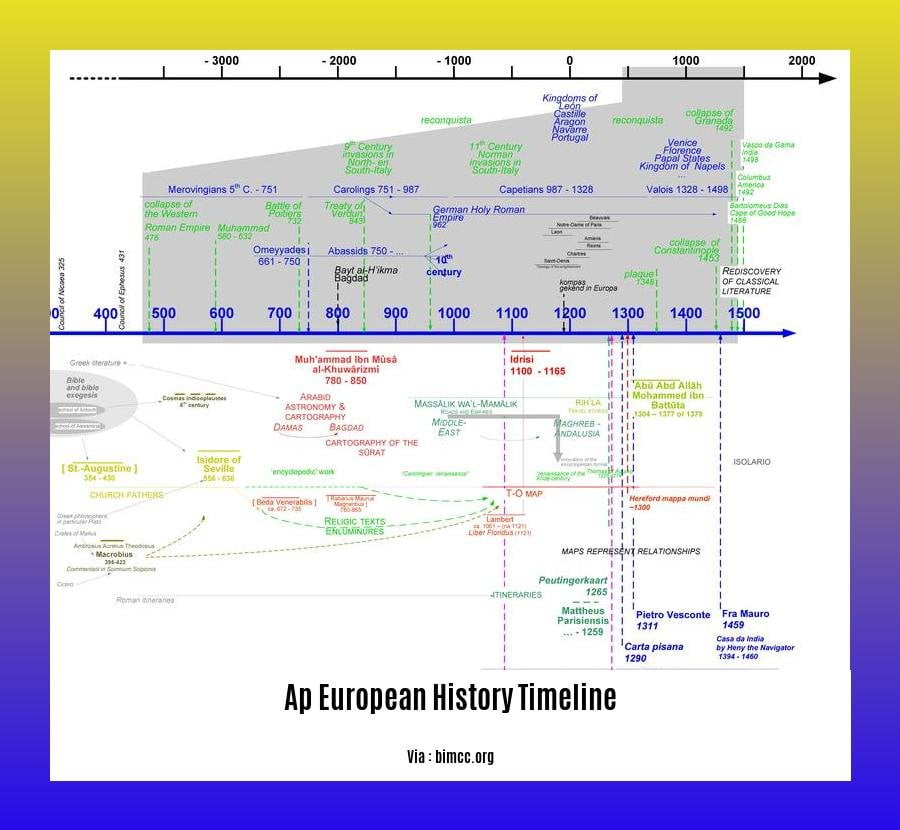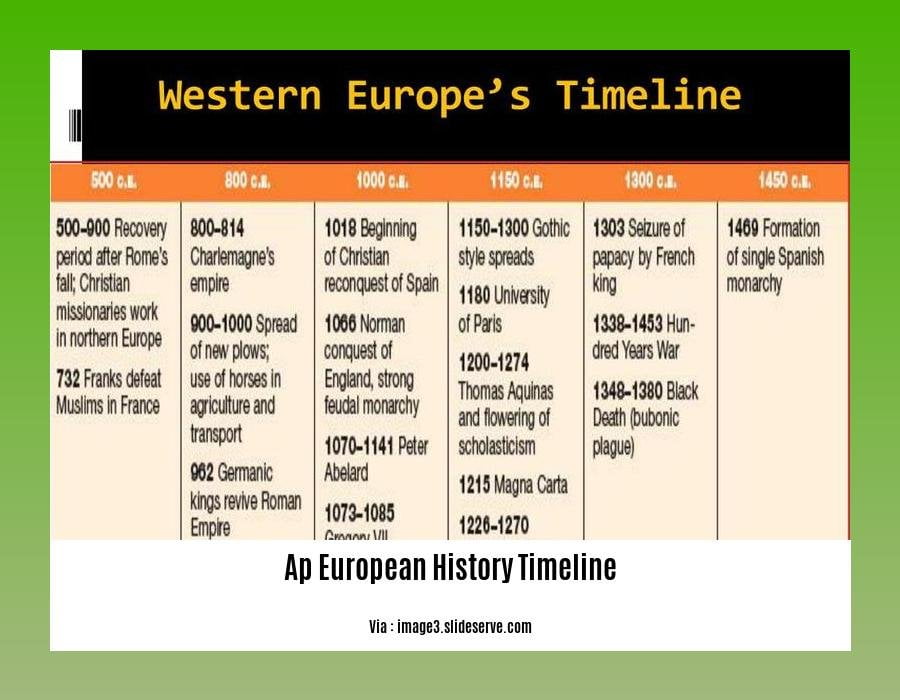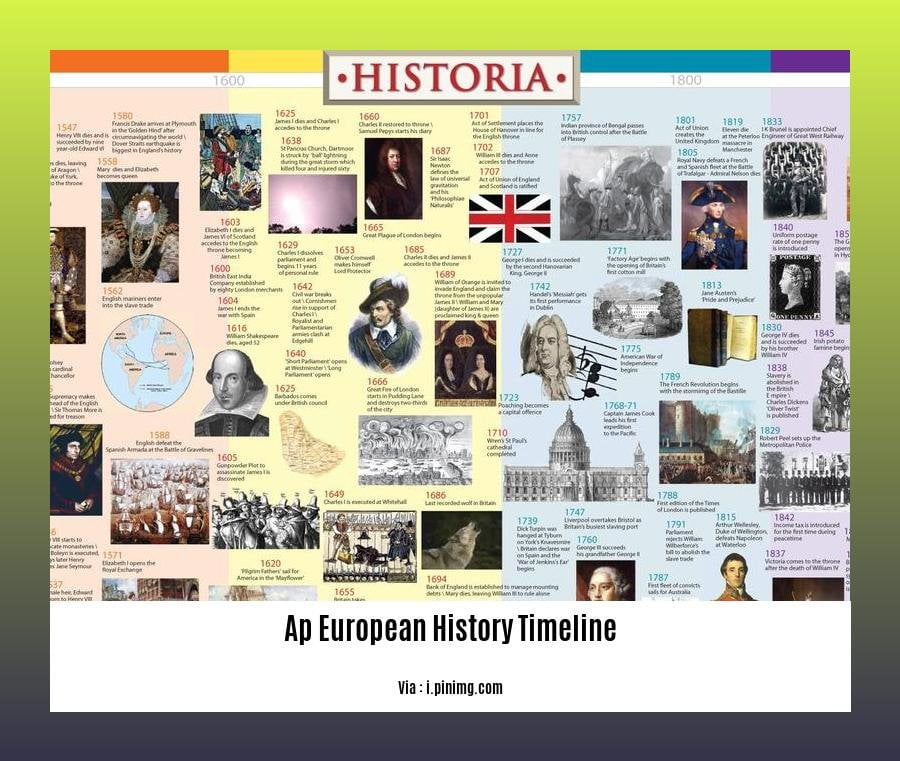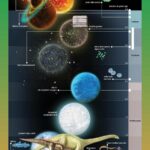Embark on a captivating journey through time as we delve into the comprehensive AP European History timeline, meticulously crafted to captivate and enlighten students. This comprehensive guide unlocks the gateway to understanding the intricate tapestry of European history, from its ancient roots to the modern era. Join us as we unravel the complexities of past events, trace the evolution of political systems, and explore the vibrant tapestry of cultural movements that have shaped the continent and continue to resonate in today’s world. Prepare to be captivated by the rich narratives and profound insights that await you in A Journey Through Time: Unveiling the AP European History Timeline.
Key Takeaways:
- The AP European History course covers four distinct time periods spanning from 1450 to the present.
- These periods include:
- 1450 to 1648
- 1648 to 1815
- 1815 to 1914
- 1914 to the Present
- Period 2 encompasses a time frame of 1648 to 1815 CE.
- The exam assesses students’ comprehension of major events, notable individuals, developments, and processes in European history throughout these four periods.
AP European History Timeline

The AP European history timeline spans a vast period from 1450 to the present, encompassing significant events, individuals, developments, and processes that have shaped the course of European history. The College Board divides this timeline into four distinct periods, each carrying equal weight in the AP European History course and exam.
Period 1: 1450-1648
- Age of Exploration:
The era of exploration and discovery, marked by voyages of Christopher Columbus, Vasco da Gama, and Ferdinand Magellan.
Protestant Reformation:
A religious movement led by Martin Luther and John Calvin, challenging the authority of the Catholic Church.
Rise of Nation-States:
The emergence of nation-states like England, France, and Spain, consolidating power and territorial boundaries.
Scientific Revolution:
- A period of intellectual and scientific advancement, including the works of Copernicus, Galileo, and Newton.
Period 2: 1648-1815
- Thirty Years’ War:
A devastating conflict in Central Europe, involving religious and political struggles.
Absolutism:
The rise of absolute monarchies, with Louis XIV of France as a prominent example.
Enlightenment:
An intellectual movement emphasizing reason, individualism, and progress.
French Revolution:
A watershed event that challenged traditional authority and ushered in new political and social ideals.
Napoleonic Wars:
- A series of military campaigns led by Napoleon Bonaparte, reshaping the political landscape of Europe.
Period 3: 1815-1914
- Congress of Vienna:
A gathering of European powers after the Napoleonic Wars, aimed at restoring stability.
Revolutions of 1848:
A wave of revolutions across Europe, striving for liberal and democratic reforms.
Industrial Revolution:
A period of technological advancements and economic growth, transforming societies.
Unification of Germany and Italy:
The creation of unified nation-states in Germany and Italy, led by Otto von Bismarck and Giuseppe Garibaldi, respectively.
Imperialism:
- The expansion of European powers into Africa, Asia, and the Americas, leading to colonial empires.
Period 4: 1914-Present
- World War I:
A global conflict that reshaped the political map of Europe and had lasting consequences.
Russian Revolution:
A series of revolutionary events in Russia, leading to the establishment of the Soviet Union.
Treaty of Versailles:
The peace treaty that concluded World War I, imposing harsh terms on Germany.
World War II:
The deadliest conflict in human history, involving the rise of Nazi Germany and the Holocaust.
Cold War:
A period of political and ideological tension between the United States and the Soviet Union.
Fall of the Berlin Wall:
A symbolic event that marked the end of the Cold War and the reunification of Germany.
European Union:
- The formation of a political and economic union among European countries, promoting cooperation and integration.
The AP European history timeline is a vast and complex tapestry of events, individuals, and developments that have shaped the world we live in today. Understanding this timeline is essential for students to grasp the interconnectedness of European history and its impact on our present-day global society.
Are you preparing for the AP European History exam? Want to ace your APUSH themes? Click on AP European History Notes to access comprehensive study materials and excel in your AP History courses.
Looking for a detailed timeline of Apple’s remarkable journey? Explore the Apple Company History Timeline to discover the key moments, innovations, and milestones that shaped the tech giant into what it is today.
The Age of Absolutism and the Development of Enlightenment Ideas
In the grand tapestry of history, the era of The Age of Absolutism and the development of Enlightenment ideas stands as a pivotal chapter that reshaped the political and intellectual landscape of Europe.
A New Era Begins
During the 17th and 18th centuries, monarchies across Europe asserted their authority, ushering in an era of Absolutism. This concept espoused the divine right of kings to rule with absolute power, unconstrained by the limitations of parliaments or other representative bodies.
The Rise of Reason
Amidst the absolutist tide, a beacon of intellectual light emerged known as the Enlightenment. This movement, characterized by its emphasis on reason, logic, and scientific inquiry, challenged traditional notions of authority and ushered in a new era of critical thinking.
Key Players
At the helm of the Enlightenment stood a constellation of brilliant minds, each contributing to the movement’s profound impact on European society.
- Isaac Newton, the scientific giant, laid the foundation of modern physics with his revolutionary theories of gravity and motion.
- John Locke, the philosopher, propounded the idea of natural rights and social contract, asserting the inherent equality of all individuals.
- Voltaire, the wit and satirist, wielded his pen as a weapon against tyranny and superstition, championing freedom of thought and expression.
Impact on Society
The Enlightenment left an indelible mark on European society, reverberating across the realms of philosophy, science, and politics.
- It challenged the divine right of kings, paving the way for democratic revolutions and the rise of modern nation-states.
- It fueled the Scientific Revolution, leading to groundbreaking discoveries that transformed our understanding of the natural world.
- It laid the groundwork for modern human rights and the concept of individual liberty, shaping the very fabric of modern societies.
Key Takeaways:
- Divine Right of Kings: Absolutism was based on the belief in the divine right of kings to rule with absolute power.
- Scientific Revolution: The Enlightenment emphasized reason and logic, leading to advances in science and technology.
- Individualism: The Enlightenment championed the idea of individual rights and liberties, challenging traditional authority.
- Legacy of Change: The Enlightenment paved the way for revolutions, the rise of democracy, and the development of modern human rights.
Sources
[1] https://www.britannica.com/event/Enlightenment-European-history
[2]
The French Revolution and the Napoleonic Wars

The tumultuous period of the French Revolution left an unforgettable mark on French history, unleashing a series of events that would reshape the landscape of Europe. With this journey through time, we’ll uncover the key moments that defined this era, from its causes to its long-reaching consequences.
The French Revolution
A Tinderbox of Grievances:
The French monarchy’s extravagance coupled with a burgeoning population led to an economic crisis.
- Political power was firmly in the hands of the king, with the privileged aristocracy and clergy exempt from most taxes.
The common people, especially the peasantry, bore the brunt of this inequality, living in poverty and enduring famine.
The Estates General:
King Louis XVI called upon the Estates General, a representative body, in a desperate attempt to solve the financial crisis.
The Third Estate, representing 97% of the population, demanded equal representation, igniting conflict among the three estates.
Storming the Bastille:
On July 14, 1789, a Parisian mob, fed up with the monarchy’s tyranny, stormed the Bastille prison, a symbol of royal authority, marking a pivotal moment in the revolution.
This act symbolized the people’s rejection of absolute monarchy and their determination for change.
Reign of Terror:
The National Convention, instilled with revolutionary fervor, established the Reign of Terror in 1793 to eliminate opposition to the revolution.
- Thousands of people, including King Louis XVI and Marie Antoinette, were guillotined during this period of intense violence and fear.
The Napoleonic Wars
A Powerhouse on the Rise:
After the French Revolution, Napoleon Bonaparte emerged as a military genius and strategic leader, leading France to numerous victories in Europe.
His goal was to expand French influence throughout Europe, establishing a vast empire.
Europe in Turmoil:
Napoleon’s relentless campaigns led to a series of conflicts known as the Napoleonic Wars, engulfing Europe in a decade of bloodshed and turmoil.
These wars transformed the European political landscape, leaving a lasting impact on its borders and power dynamics.
Waterloo: The Fall of an Empire:
Napoleon’s ambition ultimately met its match at the Battle of Waterloo in 1815, where he was defeated by a coalition of European forces.
- His defeat marked the end of the Napoleonic Wars and the beginning of a new era in European history.
Key Takeaways:
- The French Revolution was sparked by political, economic, and social grievances against the French monarchy.
- The storming of the Bastille was a pivotal moment in the revolution, marking the fall of the monarchy and the people’s fight for liberty.
- The Napoleonic Wars were a series of conflicts in which Napoleon sought to expand French influence throughout Europe.
- Napoleon’s defeat at the Battle of Waterloo in 1815 marked the end of the Napoleonic Wars and his empire.
- The French Revolution and the Napoleonic Wars left a lasting impact on the political and social landscape of Europe.
Sources:
The Industrial Revolution and its impact on European society
Get ready to delve into the transformative era of the Industrial Revolution in Europe, a period that witnessed unprecedented economic, social, and technological shifts. Its impact rippled across the continent, reshaping societies and laying the groundwork for the modern world we know today.
Key Takeaways:
- The Industrial Revolution swept across Europe between the 1780s and 1849, ushering in a new age of technological advancements.
- Technological innovations in textiles (like the spinning jenny), steam power (Watt’s steam engine), and transportation (steam locomotion) revolutionized production methods.
- Urbanization surged as people flocked from rural areas to industrial cities, drawn by the promise of jobs in factories.
- The Industrial Revolution had far-reaching social consequences, including the emergence of a working class, the rise of labor movements, and the fight for workers’ rights.
- European states became increasingly interconnected through trade and diplomacy, fostering a sense of continental unity amidst national rivalries.
Technological Advancements: The Powerhouse of Progress
The Industrial Revolution was fueled by a series of technological breakthroughs that transformed various industries and laid the foundation for mass production.
- Textiles: The invention of the spinning jenny and the power loom revolutionized textile production, allowing for the mass production of cloth and garments.
- Steam Power: James Watt’s steam engine revolutionized industries by providing a reliable and efficient source of power for factories and transportation.
- Transportation: The development of steam locomotives led to the rise of railroads, connecting cities and facilitating the transportation of goods and people.
Urbanization: The Allure of the Industrial Cities
The Industrial Revolution triggered a wave of urbanization as people migrated from rural villages to industrial cities in search of employment opportunities in factories.
- Pull Factors: The promise of jobs, higher wages, and the excitement of city life drew people to industrial centers.
- Push Factors: Rural poverty, landlessness, and the decline of traditional industries pushed people to seek new opportunities in the cities.
- Challenges: Urbanization brought its own set of challenges, including overcrowding, poor sanitation, and the spread of diseases.
The Rise of the Working Class: A New Social Order
The Industrial Revolution gave birth to a new social class—the working class—comprising factory workers, miners, and other laborers.
- Working Conditions: Factory workers often endured harsh and dangerous working conditions, long hours, and low wages.
- Labor Movements: The appalling working conditions led to the rise of labor movements and trade unions, advocating for workers’ rights and improved working conditions.
European Interconnections: A Tangled Web of Trade and Diplomacy
The Industrial Revolution fostered increased interconnectedness among European states through trade and diplomatic relations.
- Trade: Industrialization led to increased trade between European countries, as they sought raw materials, markets for finished goods, and access to new technologies.
- Diplomacy: European states engaged in diplomacy to negotiate trade agreements, resolve conflicts, and maintain a balance of power in a rapidly changing Europe.
The Industrial Revolution: A Legacy of Transformation
The Industrial Revolution left an indelible mark on European society, shaping its economic, social, and political landscape. Its legacy extends far beyond the 19th century, influencing the development of modern capitalism, globalization, and the rise of the modern nation-state.
References:
[1] Britannica, The Editors of Encyclopedia. “Industrial Revolution.” Encyclopedia Britannica, Encyclopedia Britannica, Inc., 2023, www.britannica.com/event/Industrial-Revolution.
[2] “Industrial Revolution.” History.com, A&E Television Networks, 2023, www.history.com/topics/british-history/industrial-revolution.
FAQ
Q1: What are the four chronological periods of the AP European History course?
A1: The AP European History course is divided into four chronological periods: 1450-1648, 1648-1815, 1815-1914, and 1914 to the present.
Q2: What were the main factors that led to the French Revolution?
A2: The French Revolution was sparked by a combination of factors, including economic hardship, political dissent, and the rise of the Third Estate, which represented the majority of the population but lacked political power.
Q3: What was the significance of the Enlightenment in European history?
A3: The Enlightenment was a European intellectual movement that emphasized reason, logic, and scientific inquiry. It challenged traditional beliefs and led to significant changes in philosophy, science, and politics, including the American and French Revolutions.
Q4: What were the major developments of the Industrial Revolution?
A4: The Industrial Revolution brought about technological advancements in textiles, steam power, and transportation, leading to the rise of factories and mass production. It also led to urbanization and the emergence of a working class, labor movements, and the struggle for workers’ rights.
Q5: How did the AP European History timeline influence the development of modern Europe?
A5: The AP European History timeline provides a framework for understanding the major events, individuals, and developments that shaped modern Europe, including the Enlightenment, the French Revolution, and the Industrial Revolution. These events laid the foundation for modern democracy, human rights, and the interconnectedness of European nations.
- Guatemala vs. Costa Rica: Plan Your Trip Smartly - April 16, 2025
- Master Types of Pumps: Ultimate Guide to Selection - April 16, 2025
- Unlock Types of Makeup Secrets: Master Any Look Now - April 16, 2025
















